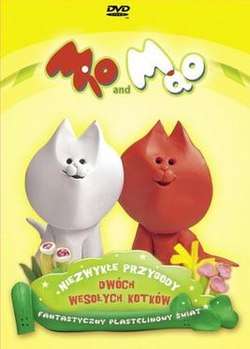Mio Mao
Mio Mao (pronounced me-o mow), also known as Mio and Mao, is an Italian stop motion children's TV show created by Francesco Misseri in the 1970s, produced using Claymation animation.[1]
| Mio Mao | |
|---|---|
 Polish DVD cover | |
| Genre | Claymation, family, preschool, children's series |
| Written by | Francesco Misseri |
| Directed by | Francesco Misseri |
| Voices of | Derek Griffiths (Channel 5) |
| Theme music composer | Piero Barbetti |
| Opening theme | Mio Mao |
| Ending theme | Mio Mao |
| Country of origin | Italy United Kingdom (series 2 and 3) |
| Original language(s) | onomatopoeia/gibberish (no dialogue) |
| No. of series | 3 |
| No. of episodes | 78 |
| Production | |
| Running time | 5 minutes |
| Production company(s) | 1974 series:
2003 series:
|
| Release | |
| Original network | Programma Nazionale (series 1) Channel 5 (Milkshake!) (series 2 and 3) |
| Picture format | 480i |
| Original release | 1974 – 2007 |
| External links | |
| Official Channel 5 Website | |
The original series was produced by PMBB and L+H Films and aired on Programma Nazionale in 1974. After Francesco Misseri's production company Misseri Studio acquired Mio Mao in 2000 and remastered series 1 in 2003, Misseri Studio and Associati Audiovisivi created two more series for Channel 5's Milkshake! block in 2006 and 2007. In the United Kingdom, the episodes are narrated and the characters are voiced by Derek Griffiths.
Plot
Each episode is approximately five minutes long and focuses on two playful kittens, a white female named Mio and a red male named Mao. As they roll, run, squish, bounce and tumble across a fantastic clay garden, they discover a variety of mysterious animals and objects on the other side. The garden changes appearance depending on the theme of the episode, or the animal or object featured.
The kittens go to investigate alone, and return scared, before watching from a distance and finding that the scary item was either a friendly animal or a fun object.
Often, near the end of the episode, the animal or object will need help, and Mio and Mao come to their rescue, then invite the animal or object to come play with them. Gracious, the animal or object follows them as they tumble and run back to the other side of the garden, posing together and looking at the viewers as the episode draws to a close, with the words "THE END".
List of episodes
Series 1 (1974)
- The Peacock
- The Little Lamb
- The Ants
- The Chameleon
- The Beehive
- The Spider
- The Tortoise
- The Caterpillar
- The Cicada
- The Egg
- The Snake
- The Dog
- The Dormouse
- The Polyp
- The Hippopotamus
- The Squirrel
- The Monkey
- The Hedgehog
- The Shell
- The Tadpole
- The Snail
- The Owl
- The Mole
- The Beaver
- The Piglet
- The Hare
Series 2 (2006)
- The Fox
- The Worm
- The Anteater
- The Seed
- The Cricket
- The Swan
- The Turkey
- The Crocodile
- The Racoon
- The Crab
- The Penguin
- The Little Bear
- The Christmas Tree
- The Snowman
- The Seal
- The Parrot
- The Mushroom
- The Dragonfly
- The Bat
- The Chestnut
- The Hornet
- The Kangaroo
- The Cow
- The Ladybird
- The Donkey
- The Koala
Series 3 (2007)
- The Deer
- The Elephant
- The Mouse
- The Ostrich
- The Pelican
- The Dove
- The Kingfisher
- The Television
- The Clew
- The Dolphin
- The Ghost
- The Goldfish
- The Zebra
- The Vacuum Cleaner
- The Sky Terrier
- The Sloth
- The Gorilla
- The Genie
- The Bull
- The Train
- The Little Theater
- The Tap
- The UFO
- The Vulture
- The Piano
- The Dinosaur
Broadcast history
Australia
Brazil
- Rede Globo (season 1)
Italy
- Rai Uno
- Junior TV (season 1)
- Rai YoYo (assorted episodes, 2013)
UK
- Milkshake!
- Channel 4 (season 1)
- BBC 2
France
Finland
United States
- BabyFirst (season 1 & 2)
Europe/Asia
Poland
Turkey
Japan
- NHK (Okaasan to Issho) (1979-1981)
- Cartoon Network (2000s)
References
- Crump, William D. (2019). Happy Holidays—Animated! A Worldwide Encyclopedia of Christmas, Hanukkah, Kwanzaa and New Year's Cartoons on Television and Film. McFarland & Co. p. 68. ISBN 9781476672939.